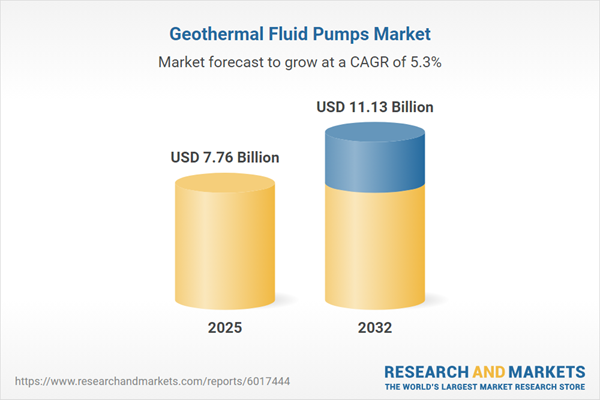Speak directly to the analyst to clarify any post sales queries you may have.
The geothermal fluid pumps market is pivotal for commercial energy transitions, allowing organizations to enhance sustainability, streamline operations, and bolster energy security across essential sectors. Senior decision-makers gain operational agility and competitive advantages through technological advancements and by responding to distinct regional market signals.
Market Snapshot: Geothermal Fluid Pumps Market Size and Growth
Global adoption of geothermal fluid pumps is on the rise. In 2024, the market is valued at USD 7.36 billion, with growth expected to USD 7.76 billion in 2025. By 2032, projections indicate an expansion to USD 11.13 billion, underpinned by a compound annual growth rate (CAGR) of 5.28%. This upward trend reflects greater commitment to sustainable energy, integration of pump digitalization technologies, and material innovations that strengthen system lifecycle and efficiency. Geothermal fluid pumps are integral to industries spanning power generation, district energy, and specialized manufacturing, each relying on carefully matched equipment to support demanding operational environments and stringent compliance mandates.
Scope & Segmentation: Comprehensive Coverage of the Geothermal Fluid Pumps Market
- Pump Types: Includes centrifugal pumps in both horizontal and vertical formats, along with positive displacement options such as gear and piston models. This diversity ensures adaptability to various geothermal fluid behaviors and installation requirements.
- Energy Sources: Covers binary cycle technologies like the Kalina and Organic Rankine Cycle, as well as double and single flash, and enhanced geothermal systems. Each energy source creates its own material and efficiency standards for deployed pump systems.
- Application Areas: Encompasses district heating networks, supply for industrial process heat, and both on- and off-grid electricity production. Operators face unique integration and performance challenges depending on the use case.
- Deployment Modes: Highlights submersible and surface-mounted pumps to serve new projects and upgrades of legacy geothermal systems, aligning with different well geometries and site restrictions.
- End User Profiles: Focuses on commercial operators, industrial organizations, independent power producers, and utility sectors, each with nuanced procurement standards and technical requirements.
- Power Output Classes: Addresses the need for project-specific capacities, from compact systems below 10 MW up to installations beyond 50 MW, shaping engineering complexity and project integration scope.
- Material Types: Features solutions constructed from cast iron, duplex stainless steel, and specialty alloys that meet rigorous corrosion resistance, cost, and integrity demands in geothermal environments.
- Geographic Regions: Assesses expanding trends and policy dynamics in the Americas, Europe, Middle East and Africa, and Asia-Pacific. Key markets—including the United States, Germany, Kenya, Japan, and Australia—exhibit distinct approaches based on regional policy and infrastructure development.
- Key Players: Profiles companies such as Flowserve Corporation, Sulzer Ltd, Grundfos Holding A/S, KSB SE & Co. KGaA, Ebara Corporation, ITT Inc., Wilo SE, The Weir Group PLC, ANDRITZ AG, and Baker Hughes Company, which shape technology trajectories and supply sector-critical equipment.
Key Takeaways: Strategic Insights for Senior Decision-Makers
- Modern geothermal fluid pumps are designed to align with decarbonization and sustainability objectives, reinforcing energy infrastructure resilience for enterprise and industrial organizations.
- Real-time, IoT-enabled monitoring and predictive analytics empower organizations to improve oversight, lower maintenance demands, and reduce the likelihood of downtime or service disruptions.
- Advanced materials in pump and seal design extend operational life, aiding long-term asset management and supporting robust performance in high-temperature projects.
- Procurement priorities are evolving, with an increased focus on lifecycle value and reliability rather than initial acquisition costs, guiding supplier evaluation and procurement frameworks.
- Modular and customizable system architectures simplify both retrofitting of legacy installations and the development of new geothermal assets, allowing operators to meet a variety of technical and project requirements.
Tariff Impact
The introduction of U.S. tariffs in 2025 has generated additional pricing and supply chain complexities for geothermal fluid pumps market participants. Organizations are rebalancing sourcing strategies, emphasizing local suppliers, and establishing strategic alliances to mitigate uncertainty and preserve project timelines.
Methodology & Data Sources
This analysis is based on interviews with senior executives at leading manufacturing organizations and project developers, complemented by a detailed review of technical documentation, regulatory disclosures, and expert commentary. Findings are validated through process analyses and direct stakeholder engagement to ensure relevance for procurement and executive management.
Why This Report Matters for Geothermal Fluid Pumps Market Stakeholders
- Access actionable analysis of evolving technologies, policy shifts, and untapped market opportunities to inform investment decisions and strategic resource allocation.
- Identify effective efficiency drivers and resilient supply chain practices applicable to diverse regional contexts for improved risk and procurement management.
- Use targeted segmentation and regional insights to enhance business development plans, navigate market entry, and build strong competitive positioning.
Conclusion
Technological progress, regulatory evolution, and growing geographic adoption are reshaping the geothermal fluid pumps market. Senior leaders can utilize this report to refine investment strategies, maximize operational efficiencies, and stay prepared for industry transformation.
Additional Product Information:
- Purchase of this report includes 1 year online access with quarterly updates.
- This report can be updated on request. Please contact our Customer Experience team using the Ask a Question widget on our website.
Table of Contents
3. Executive Summary
4. Market Overview
7. Cumulative Impact of Artificial Intelligence 2025
Companies Mentioned
The companies profiled in this Geothermal Fluid Pumps market report include:- Flowserve Corporation
- Sulzer Ltd
- Grundfos Holding A/S
- KSB SE & Co. KGaA
- Ebara Corporation
- ITT Inc.
- Wilo SE
- The Weir Group PLC
- ANDRITZ AG
- Baker Hughes Company
Table Information
| Report Attribute | Details |
|---|---|
| No. of Pages | 193 |
| Published | November 2025 |
| Forecast Period | 2025 - 2032 |
| Estimated Market Value ( USD | $ 7.76 Billion |
| Forecasted Market Value ( USD | $ 11.13 Billion |
| Compound Annual Growth Rate | 5.2% |
| Regions Covered | Global |
| No. of Companies Mentioned | 11 |









